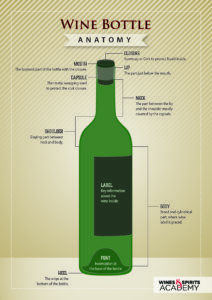Share
The Anatomy Of A Wine Bottle: Know A Wine Bottle Head To Toe
The wine bottle body is equally elegant as the wine it holds. It comes as no surprise that each part of the bottle has name. Are you familiar with these terms?
Closure
 Closures can come in the form or cork or screw-cap. It is used for better preservation of wine, so that wine doesn’t come in contact with air. Plastic closures are also available to seal wine after opening it.
Closures can come in the form or cork or screw-cap. It is used for better preservation of wine, so that wine doesn’t come in contact with air. Plastic closures are also available to seal wine after opening it.
Capsule
It is the wrapping around the closure with a thin metal sheet. It protects the cork from drying up and prevents the wine from evaporating.
Neck
Below the closure is the neck of the wine. It’s the slender part of the bottle. It also acts as a grip to hold the bottle of the wine. Wine’s top-level lies in the neck of a closed bottle, if not then it is either leaked or evaporated through the cork.
Shoulder
It’s a sloping part below the neck. It is different in different shaped bottles Burgundy wine bottles do not have clear visible shoulders and Bordeaux bottles have obvious shoulders.
Body
The main broad part of the bottle, normally in a cylindrical shape is the body of the bottle.
Label
The body of the wine bottle is adorned with a label showcasing information about the wine. Some of the information is controlled by regulations in a country. The front label consists of information like name of the company, brand name, grape varietal, vintage, abv. The back label has information like origin country, description of the wine, price andvolume.
Punt
It is a hollow dent on the underside of the bottle. It strengthens the bottle. Punt size can be different and sometimes a wine bottle can be without a punt.
Heel
The base of the wine bottle is a Heel that helps the bottle to stand up straight.
Different looking wine bottles can depict a region. Wine making regions adopt a wine bottle shape that suits best to their wine.
- Bordeaux bottles are straight-sided and high prominent shouldered with a bigger punt. They have a dark green glass for reds and light green for whites, sweet wines are in a colorless glass bottle.
- Burgundy and Rhône varieties are usually tall bottles with sloping shoulders and a smaller punt. It is always dark green in colour.
- Alsace varieties are typically in a more narrow and tall bottle with small or no punt. Bottles are green in colour.
- Champagne and sparkling wines are often thick-walled and wide with a pronounced punt and sloping shoulders like a bigger Burgundy bottle. The colour of the bottles range from dark to medium green.
- Italian wines and Chianti for their table wines have traditional bottle shape, for example, a Fiasco – a big round bottom flask covered in a straw basket.
- Rosé wines or Rosé sparkling wines are usually in a colourless bottle.







